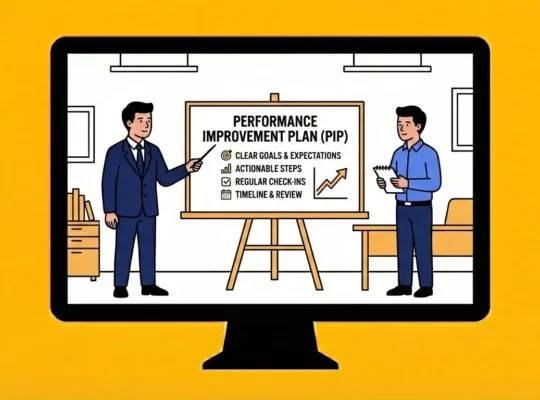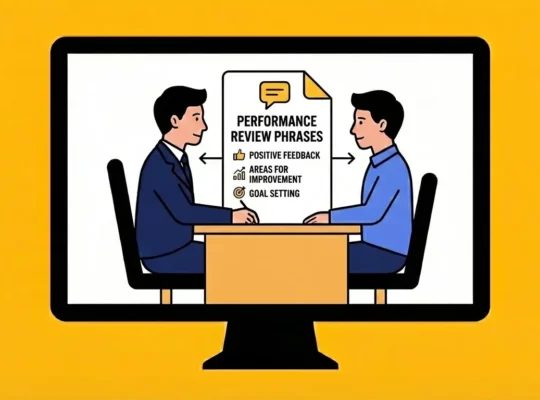Succession planning best practices are crucial for ensuring the stability and growth of any organization. Almost all employers (94%) said that having a succession plan positively impacts their employees’ engagement levels. Review.jobs understands the importance of having a solid plan in place to maintain leadership continuity and address future challenges. This article will guide HR professionals, company leaders, and other stakeholders through the top strategies to ensure their succession plans are robust and effective.
Table of Contents
- Align Succession Planning with Organizational Goals
- Identify Key Positions and Critical Roles
- Develop a Talent Pipeline
- Establish Clear Criteria for Selection
- Invest in Leadership Development Programs
- Foster a Culture of Continuous Improvement
- Plan for Multiple Successors
- Regularly Review and Update Succession Plans
- Utilize Technology and Data Analytics
- Communicate the Succession Plan
1. Align Succession Planning with Organizational Goals
Aligning succession planning with your organization’s goals ensures that your succession planning process supports your strategic vision. Start by understanding your company’s long-term objectives and identify how leadership roles contribute to these goals. Integrating succession planning into your strategic plan guarantees that you’re preparing future leaders who can drive your organization forward.
Understanding the Organization’s Vision and Goals
Every organization has a unique vision and set of goals. To align succession planning effectively, it’s crucial to grasp these guiding principles thoroughly. This alignment starts with a deep dive into your company’s mission statement, core values, and strategic objectives. By understanding where the organization aims to be in the future, you can better prepare potential successors who are not only skilled but also aligned with the company’s ethos and direction.
Integrating Succession Planning into Strategic Planning
Succession planning should be an integral part of your strategic planning efforts. This means weaving succession planning goals into the broader organizational strategy. Start by conducting a thorough analysis of your current leadership capabilities and identifying gaps that might hinder achieving long-term objectives. Establishing clear succession plans that map out the development and readiness of high-potential leaders can ensure a seamless transition in leadership, and foster stability and continuity.
2. Identify Key Positions and Critical Roles
Identifying key positions and critical roles within your organization is fundamental to effective succession planning. These roles are essential for the business’s success and should be prioritized in your succession planning strategy.
Criteria for Identifying Key Positions
Determining which positions are key requires careful analysis. Consider roles that have a significant impact on your organization’s strategic objectives and overall operations. Key positions typically include those at the executive level but pay attention to critical roles at other levels vital to the company’s day-to-day functionality.
- Strategic importance: How critical is the role to achieving the organization’s strategic goals?
- Operational impact: What is the impact of the role on daily operations and overall business performance?
- Replacement difficulty: How challenging would it be to replace the employee currently in this role?
Importance of Each Role to the Organization’s Success
Every key role contributes uniquely to the organization’s success. Understanding the specific impact of each role helps prioritize which positions need immediate focus in your succession planning. For instance, a CFO’s role in maintaining financial health is as crucial as a Head of Product’s role in innovation and product development. By mapping out these impacts, you can ensure that your succession plans cover all critical aspects of your business.
Tools and Methods for Identifying Critical Roles
Various tools and methods can assist in identifying critical roles within your organization:
- Organizational charts: Visual representations of your organizational structure can help identify key positions and understand reporting lines and interdependencies.
- Job analysis: Detailed job analysis provides insights into the skills, competencies, and responsibilities required for each role, highlighting those that are critical.
- Performance evaluations: Regular performance reviews can reveal which roles are crucial based on the performance and impact of current role holders.
Using these tools effectively will enable you to create a succession planning model that ensures all critical roles are accounted for and that there are clear pathways for potential employees to move into these positions when necessary.
3. Develop a Talent Pipeline
Creating a talent pipeline within your organization is essential for ensuring a steady flow of capable leaders ready to step into critical roles. This involves identifying and nurturing high-potential employees who demonstrate the skills, competencies, and values aligned with your organization’s goals.
Creating a Talent Pool Within the Organization
A talent pool is a dynamic collection of employees who have been identified as potential leaders. Building this pool requires a proactive approach:
- Internal talent audits: Regularly assess the skills, competencies, and performance of current employees to identify those with leadership potential.
- Employee development programs: Implement comprehensive development programs that include training, workshops, and rotational assignments to prepare employees for future leadership roles.
- Succession planning tools: Utilize tools that track employee performance, potential, and readiness for advancement to maintain an up-to-date talent pool.
Strategies for Identifying and Nurturing Potential Leaders
Identifying potential leaders involves more than just evaluating current performance; it’s about recognizing future potential. Consider these strategies:
- Performance reviews: Use regular performance reviews to identify employees who consistently exceed expectations and demonstrate leadership qualities.
- Leadership assessments: Conduct assessments to evaluate leadership competencies, such as strategic thinking, decision-making, and emotional intelligence.
- Career pathing: Develop clear career paths for employees, outlining the steps and development needed to advance to leadership positions.
Role of Mentoring and Coaching in Talent Development
Mentoring and coaching are powerful tools for developing future leaders. They offer personalized guidance and support that can significantly enhance an employee’s growth:
- Mentorship programs: Pair potential leaders with experienced mentors who can share insights, provide advice, and offer career guidance.
- Coaching sessions: Professional coaches can help employees develop specific skills, overcome challenges, and achieve personal and professional goals.
- Peer mentoring: Encourage a culture where peer mentoring is common, allowing employees to learn from each other and build a collaborative learning environment.
4. Establish Clear Criteria for Selection
Establishing clear and objective criteria for selecting potential successors ensures a fair and transparent succession planning process. This helps identify the right individuals for key roles and prepares them effectively for future leadership positions.
Defining Competencies and Skills Required for Key Positions
Defining the specific competencies and skills required for key positions is the foundation of an effective selection process. This involves:
- Job analysis: Conduct a detailed analysis of each key position to identify the skills, knowledge, and abilities necessary for success.
- Competency frameworks: Develop frameworks that outline the essential competencies for leadership roles, such as strategic vision, communication, and decision-making.
- Behavioral indicators: Define clear behavioral indicators that exemplify the competencies needed, making it easier to assess potential candidates.
Objective Assessment Tools and Methods
The effective use of objective assessment tools and methods ensures that the selection process is unbiased and merit-based. Consider the following:
- Psychometric tests: These tests can measure cognitive abilities, personality traits, and emotional intelligence, providing a comprehensive view of a candidate’s potential.
- 360-degree feedback: Gather feedback from a candidate’s peers, subordinates, and supervisors to get a well-rounded perspective on their performance and leadership capabilities.
- Assessment centers: Simulate real-world scenarios to evaluate how candidates handle leadership challenges and make decisions.
Importance of Transparency in the Selection Process
Transparency in the selection process is crucial for maintaining trust and morale within the organization. When employees understand how decisions are made, they are more likely to engage with and support the succession planning strategy:
- Clear communication: Communicate the criteria, process, and timelines for succession planning to all employees.
- Involvement of stakeholders: Involve key stakeholders, including senior leaders and HR professionals, in the selection process to ensure diverse perspectives and buy-in.
- Feedback loops: Provide constructive feedback to all candidates, whether they are selected for a leadership role or not, to help them understand their strengths and areas for development.
5. Invest in Leadership Development Programs
Investing in leadership development programs is a cornerstone of effective succession planning. Companies around the world spend billions per year on leadership development, underscoring the value placed on cultivating future leaders.
Types of Leadership Development Programs
Various leadership development programs can be tailored to meet the unique needs of an organization and its potential employees. Here are some of the most effective types:
- Training workshops: These are structured sessions focusing on specific skills, such as strategic planning, decision-making, and team management. Workshops often include interactive elements like role-playing and group discussions.
- Rotational assignments: These programs allow employees to work in different departments or roles within the organization, providing a broad understanding of the business and developing versatile skills.
- Executive coaching: Personalized coaching helps individuals identify their strengths and weaknesses, set goals, and develop a plan for growth. Coaches provide feedback and support throughout the leadership development journey.
- Mentorship programs: Pairing employees with experienced mentors provides guidance, knowledge sharing, and career advice. Mentors can help mentees navigate challenges and develop their leadership skills.
- E-learning and online courses: These flexible programs allow employees to learn at their own pace and often cover a wide range of topics relevant to leadership development.
Benefits of Continuous Learning and Development
Continuous learning and development offer several significant benefits:
- Enhanced skills and competencies: Regular training ensures that employees are up-to-date with the latest industry trends and practices, making them more effective in their roles.
- Increased employee engagement: Embrace an employee-first culture and support your employees in pursuing their ambitions. When employees see opportunities for growth and development, they are more likely to be engaged and committed to the organization.
- Better succession planning: A well-developed talent pipeline ensures that there are always qualified candidates ready to step into leadership positions when needed.
- Improved organizational performance: Leaders who are continually learning and developing can drive better business outcomes, fostering innovation and improving efficiency.
6. Foster a Culture of Continuous Improvement
Creating a culture of continuous improvement is vital for sustaining long-term success and effective succession planning. This culture encourages feedback and open communication, promoting an environment where learning and adaptation are constant.
Encouraging Feedback and Open Communication
Open communication and regular feedback are the bedrock of continuous improvement. Here’s how to foster this culture:
- Authentic employee reviews: Succession planning thrives on transparency. Gathering honest employee feedback, through platforms like Review.jobs, fosters a culture of open communication. This allows companies to understand employee needs, identify potential leaders, and refine their employer brand. By incorporating employee insights, companies can make informed decisions to create a better work environment, ultimately leading to a smoother succession process.
For more options, check out our list of the best 10 employee feedback tools for a thriving workforce.
- Regular check-ins: Schedule regular one-on-one meetings between employees and managers to discuss progress, address concerns, and set goals. This ongoing dialogue helps keep employees engaged and focused on development.
- Anonymous suggestion boxes: Encourage employees to share ideas and feedback anonymously. This can help surface valuable insights and foster a culture of openness and trust.
Emphasizing the Importance of Ongoing Learning and Adaptation
In a rapidly changing business environment, ongoing learning and adaptation are essential. Organizations should:
- Promote continuous education: Encourage employees to pursue further education, attend industry conferences, and participate in professional development opportunities.
- Provide learning resources: Make resources such as online courses, workshops, and training materials readily available to employees. This demonstrates a commitment to their growth and development.
- Celebrate learning milestones: Recognize and reward employees who achieve learning milestones, whether it’s completing a course, earning a certification, or mastering a new skill. Celebrating these achievements reinforces the value of continuous learning.
7. Plan for Multiple Successors
Effective succession planning involves having a robust strategy that accounts for multiple potential successors for each key role within an organization. This approach minimizes risk and ensures the organization can continue to thrive even if unexpected changes occur.
Avoiding Reliance on a Single Successor
Relying on a single successor can be risky. If that person decides to leave the company or is unable to step into the role, the organization could face significant disruption. In 73% of companies, the most common method for identifying individuals as potential candidates for leadership positions was a single nomination by their direct manager. This method, while straightforward, does not provide a fallback option if the chosen successor becomes unavailable.
Developing a Bench Strength of Potential Leaders
To avoid this pitfall, organizations should focus on building a bench strength of potential leaders. This involves:
- Identifying multiple candidates for each critical role to ensure a pool of capable individuals.
- Encouraging broad-based leadership development to prepare a wide range of employees for future opportunities.
- Creating opportunities for cross-functional experiences to develop versatile leaders who can step into various roles.
Strategies for Multi-Tiered Succession Planning
Implementing multi-tiered succession planning ensures that there are always several high-potential employees ready to step into leadership roles. Strategies include:
- Layered Succession Plans: Develop succession plans that identify immediate, intermediate, and long-term successors for each key role. This approach ensures that there is always someone ready to step in, regardless of the timing of the transition.
- Talent Pools: Create and maintain talent pools of potential successors who are continuously groomed for various leadership positions. This ensures a steady pipeline of prepared leaders.
- Regular Assessments: Conduct regular assessments of potential leaders to ensure they are developing the necessary skills and competencies. Use tools like 360-degree feedback and performance reviews to gather comprehensive insights.
8. Regularly Review and Update Succession Plans
A succession planning process is not a one-time event but an ongoing effort that requires regular reviews and updates. This ensures the plans remain relevant and aligned with the organization’s evolving needs.
Importance of Periodic Reviews and Updates
Periodic reviews are critical for maintaining the effectiveness of succession plans. Regular reviews help identify any gaps or areas where the plan may need adjustment, ensuring the organization remains prepared for future transitions.
Adapting to Changing Organizational Needs and External Factors
Organizations operate in dynamic environments where changes are constant. Factors such as market trends, technological advancements, and shifts in business strategy can impact succession planning. Therefore, it’s essential to:
- Monitor industry trends and adjust succession strategies accordingly.
- Stay agile to respond to internal changes, such as mergers, acquisitions, or restructuring.
- Update the criteria for potential leaders based on the evolving needs of the business.
Best Practices for Conducting Succession Plan Reviews
- Regular intervals: Schedule reviews at least annually or bi-annually to ensure the plans are up-to-date.
- Comprehensive evaluation: Assess both the potential successors and the overall succession strategy. This includes evaluating the progress of individuals in the talent pipeline and the effectiveness of development programs.
- Data-driven insights: Utilize data analytics to track the progress and effectiveness of succession planning efforts. Tools like performance dashboards can provide valuable insights into the readiness of potential successors.
9. Utilize Technology and Data Analytics
Leveraging technology and data analytics can significantly enhance the succession planning process by providing actionable insights and streamlining workflows.
Leveraging HR Technology for Succession Planning
HR technology has transformed the way organizations manage succession planning. Modern HR software solutions offer a range of tools that can help:
- Track employee performance and identify high-potential employees.
- Automate talent assessments to ensure objective and consistent evaluations.
- Facilitate learning and development programs through e-learning platforms and online training modules.
Using Data Analytics to Inform Decision-Making
Data analytics plays a crucial role in making succession planning more effective. By analyzing various data points, organizations can make informed decisions about their succession strategies. Key benefits include:
- Identifying trends and patterns in employee performance and development.
- Predicting future leadership needs based on current data and trends.
- Measuring the impact of development programs on employee readiness.
Examples of Technology Tools for Effective Succession Planning
- Talent Management Systems: These comprehensive systems integrate various HR functions, including succession planning, performance management, and learning and development.
- People Analytics Platforms: These tools analyze workforce data to identify potential leaders and assess their readiness for leadership roles.
- Leadership Development Software: These platforms offer personalized development plans, tracking progress and providing feedback to prepare employees for future leadership positions.
10. Communicate the Succession Plan
Effective communication is essential for the success of any succession planning initiative. Clear and transparent communication helps ensure that all stakeholders understand the process and their roles within it.
Importance of Clear and Transparent Communication
Clear communication about the succession planning process helps build trust and buy-in from employees and other stakeholders. It ensures that everyone is aware of the organization’s plans for future leadership transitions and understands the opportunities available to them.
Strategies for Communicating with Stakeholders
To communicate the succession plan effectively, organizations should consider the following strategies:
- Regular updates: Keep all stakeholders informed about the progress of the succession planning efforts through regular updates.
- Open forums: Hold meetings or town halls to discuss the succession planning model and answer any questions employees may have.
- Documentation: Provide clear documentation that outlines the succession planning process, criteria for selection, and development opportunities.
Managing Expectations and Addressing Concerns
Managing expectations and addressing concerns is a critical aspect of communicating the succession plan. This involves:
- Setting realistic expectations: Ensure that employees understand the criteria for leadership positions and the development process.
- Providing feedback: Offer regular feedback to potential successors about their progress and areas for improvement.
- Addressing concerns: Be open to listening to and addressing any concerns employees may have about the succession planning strategy. This helps in maintaining morale and ensuring that the process is viewed positively.
By following these 10 succession planning best practices, organizations can ensure a robust leadership pipeline. Effective succession planning offers long-term benefits, such as improved employer image, employee engagement, and organizational stability. At Review.jobs, we encourage companies to implement these practices to secure a bright and sustainable future for their leadership.





